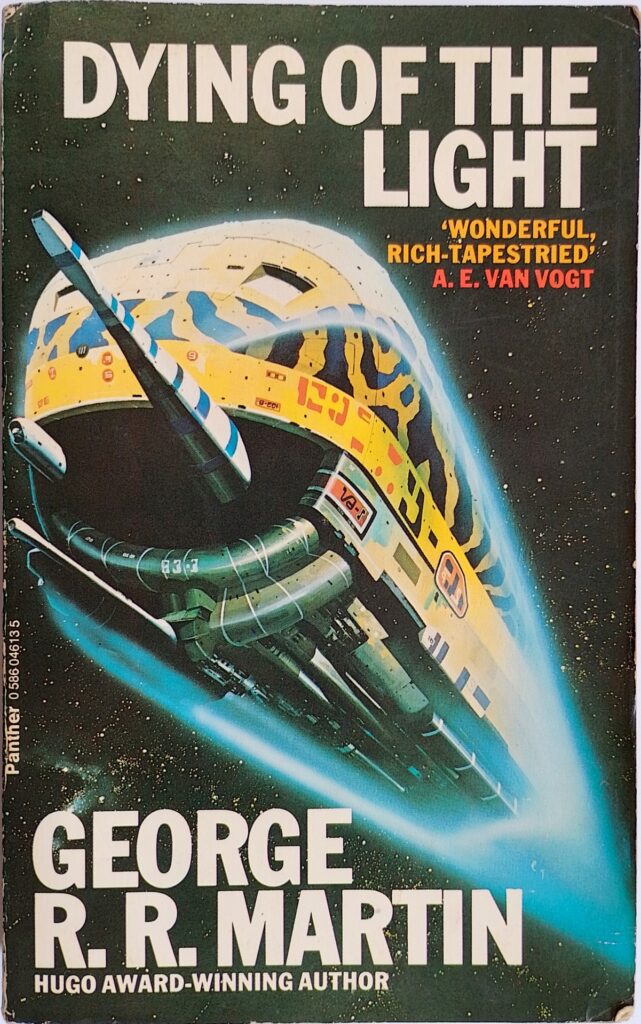First published 1977. Panther, paperback, 1979, pp 316, c.105,000 words.
Classified as Science Fiction in 1979, the book has a cover showing a spaceship glowing as it dashes across a starry background. Today it would be on the Fantasy shelves, as that genre now has eclipsed Science Fiction and Martin is one of its leading exponents. This was nominated for the British Fantasy Award in 1979, so recognised as such even then. The boundaries between genres are blurred, of course. One might say that all fiction is fantasy, but the category today generally includes things that are forbidden by the currently accepted laws of physics, and often contains ‘swords and sorcery’, with many cod-Norse saga elements. However, much real science fiction includes faster-than-light communications and travel, otherwise there would be no way for events to happen in more than one star system, and even if travel is confined to the solar system there would be very long dull voyages to get from one planet to the next. Fantasy allows ‘superheroes’ with magical powers and other childish elements. It doesn’t generally appeal to the older reader.
This was Martin’s first novel, written when he was in his late twenties, and it comes across as a young-man’s book, and one already disillusioned with life. Martin had sold a number of short stories to magazines prior to this, one of which had won a Hugo award.
Most of the main protagonists in this book are from a planet where a group of tribes have a codified, aggressive, warrior culture that is reminiscent of Viking or Germanic tribes of the Roman period. They have a powerful macho honour code that directs their relationships and behaviour. It is completely misogynistic, with women treated as property and easily discarded to become common breeding stock. Men form deep long-term relationships with another man. The story centres on someone from a liberal world who is summoned by a promise made to a former girlfriend, who he now discovers has become the mistress and property of a powerful warrior, who happens to be his male partner.
The meeting takes place on a planet that has been detached from a star and is wandering the galaxy, but for a brief, ten-year, period came in close enough to a multi-star system to be warmed up. For that time it became a festival world, but now the festival has ended and the planet is dying. There are loving descriptions of several of the cities that neighbouring planets built for the festival, but which are now largely abandoned. This is one of the structural problems with the novel. Martin is so keen on ‘world building’ – and he is very good at it – that he has forgotten about driving the plot; for the first hundred pages almost nothing happens. It’s not as though he isn’t capable of delivering high octane action either: there is a powerfully exciting section in the middle of the book that involves hunters and hunted.
The characters don’t entirely convince. The protagonist is a winger, for ever moping and moaning about his lost love. The central woman doesn’t seem at all clear about what she wants: her motivation seems to be missing as she flops back and forth. The main warrior is a more complex character, conflicted by his loyalty to his tribe and his love for a liberal off-worlder, but he is not very articulate. There are some nice villains but they are a bit too straight-forward, bad guys.
The ending is a disaster. Completely unsatisfying. We are left to speculate on what happens to the main characters. We can take a dark ending if it works. Perhaps he was intending to write a sequel but never did.
The writing is mostly clear and makes for easy reading. There were a few places where tighter editing might have been worthwhile. A glossary is included at the end that gives descriptions of the invented planets, tribes, beasts, and some prior events. It is clear that Martin spent a considerable amount of effort on his well realised ‘world building’.
Twenty years after writing this, Martin wrote A Song of Ice and Fire which became the basis for the hugely successful HBO television series, A Game of Thrones. Apparently he based the idea on the Wars of the Roses.
Oh, that spaceship on the cover? There is only one spaceship journey and that is not described in any detail or holds any significance to the plot. Pure marketing, and I was suckered.
© William John Graham, October 2022

